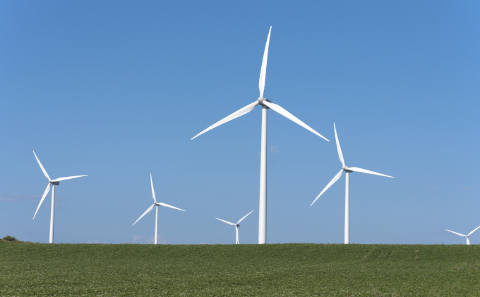Minimising energy loss in offshore wind farms

A collaboration between Engineering at Southampton and Flightform Insights has developed a novel wake and wind generation model that aims to minimise energy loss in offshore wind farms.
The University is a partner of the national SPace Research and Innovation Network for Technology (SPRINT) business support programme that provides unprecedented access to the expertise and facilities at top UK space universities to help businesses accelerate the development of their products and services through the commercial exploitation of space data and technologies.
Flightform Insights wanted to team up with SPRINT partner, the University of Southampton, to apply its world-class expertise in fluid dynamics to renewable energy.
Flightform Insights serves the energy industry with data analytics and professional consulting services derived from satellite earth observation. Its goal is to transform the planning and pre-planning phases of offshore wind projects by helping offshore wind developers to optimise the turbine layout of their windfarms, minimising the losses caused by the influence of the turbine wake on the water surface.
The SPRINT project looked at helping develop a novel wake and wind generation model that could predict the energy output and estimated energy losses from any configuration of wind turbines, thus minimising energy losses from offshore wind farms. It focused on the observation of real-life wakes – the ‘wind shadows’ cast by wind turbines – that reduce the wind speed and alter the wind flow characteristics for adjacent turbines downwind. It used a combination of earth observation satellite images of European offshore wind farms and existing theoretical models to observe wakes on the water surface in offshore wind farms.
Professor of Maritime Fluid Dynamics Stephen Turnock, Head of Southampton’s Civil, Maritime and Environmental Engineering said: “Our expertise covers maritime engineering and renewable energy, and the team at Flightform were looking for specific expertise in joining up the data to confidently predict the performance of wind turbine arrays.
“The SPRINT project was a unique opportunity to do this at scale, with a range of sites and a long timescale, and has extended our experience of working in commercial environments.
“It was interesting to understand how turbines perform in arrays and use the data to effectively operate wind turbines. This cutting-edge industry perspective is useful for us to apply to teaching and research, and indeed, the knowledge gained from datasets has already been fed into academic teaching this year.”
Founder at Flightform Insights Tatiana Suarez added: “This particular project looked at the best layout of wind farms to minimise energy loss for developers and operators. We heard about SPRINT at an accelerator event and the University of Southampton expertise was very applicable for this project. Although we have a product in the pipeline, we needed additional resources and capability to help us get to the first stage design of a commercial model and that is what SPRINT has helped to deliver.
“The collaboration with the University of Southampton has been invaluable for us, helping us to progress towards achieving our objectives. We’ve now progressed with the wind angle part of the process with good confidence but need a bit more work on wind speeds. We can then physically model our wake model.
“The access to expertise has been irreplaceable and resulted in major time gains so we would definitely consider partnering with academia again for further commercialisation.”